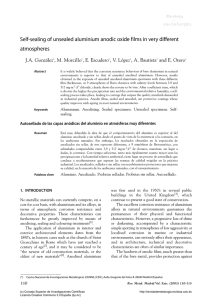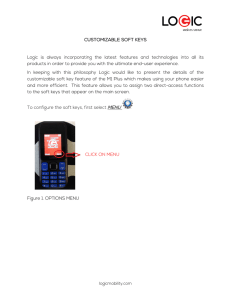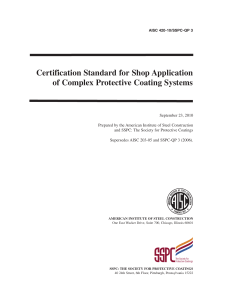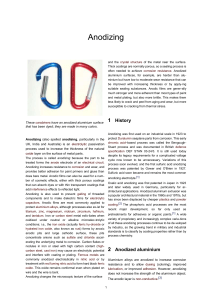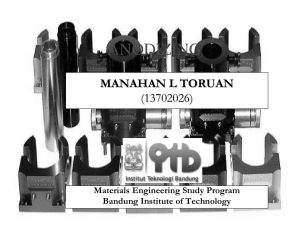Contribution of electron microscopy to the study of sealing
Anuncio
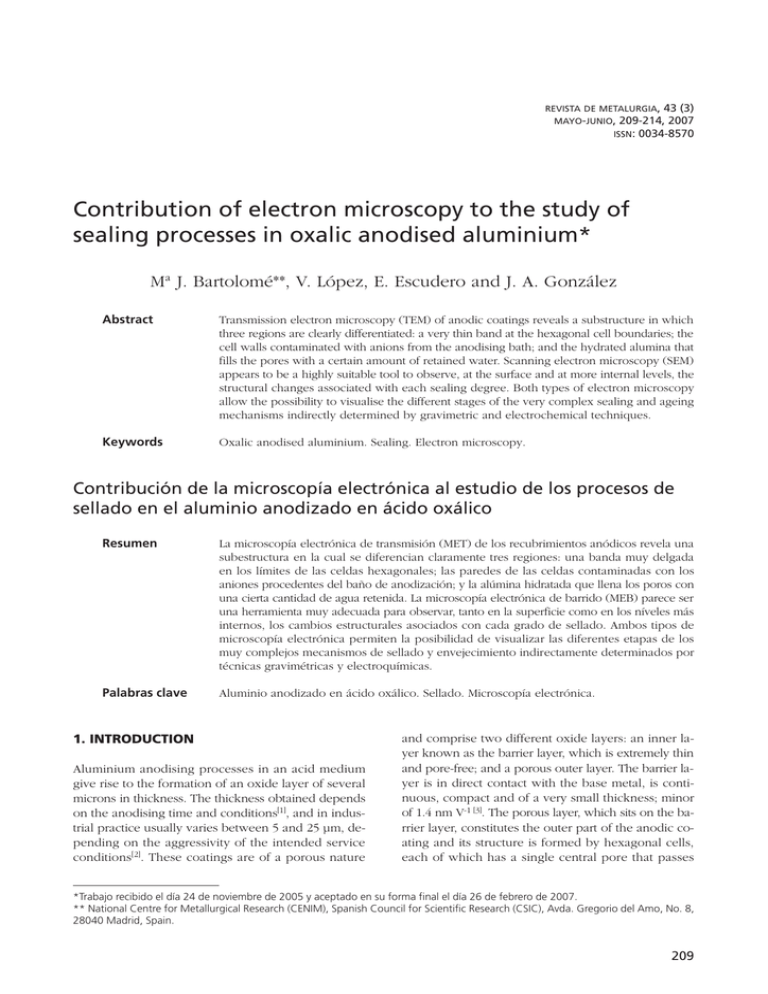
REVISTA DE METALURGIA, 43 (3) 209-214, 2007 ISSN: 0034-8570 MAYO-JUNIO, Contribution of electron microscopy to the study of sealing processes in oxalic anodised aluminium* Mª J. Bartolomé**, V. López, E. Escudero and J. A. González Abstract Transmission electron microscopy (TEM) of anodic coatings reveals a substructure in which three regions are clearly differentiated: a very thin band at the hexagonal cell boundaries; the cell walls contaminated with anions from the anodising bath; and the hydrated alumina that fills the pores with a certain amount of retained water. Scanning electron microscopy (SEM) appears to be a highly suitable tool to observe, at the surface and at more internal levels, the structural changes associated with each sealing degree. Both types of electron microscopy allow the possibility to visualise the different stages of the very complex sealing and ageing mechanisms indirectly determined by gravimetric and electrochemical techniques. Keywords Oxalic anodised aluminium. Sealing. Electron microscopy. Contribución de la microscopía electrónica al estudio de los procesos de sellado en el aluminio anodizado en ácido oxálico Resumen La microscopía electrónica de transmisión (MET) de los recubrimientos anódicos revela una subestructura en la cual se diferencian claramente tres regiones: una banda muy delgada en los límites de las celdas hexagonales; las paredes de las celdas contaminadas con los aniones procedentes del baño de anodización; y la alúmina hidratada que llena los poros con una cierta cantidad de agua retenida. La microscopía electrónica de barrido (MEB) parece ser una herramienta muy adecuada para observar, tanto en la superficie como en los níveles más internos, los cambios estructurales asociados con cada grado de sellado. Ambos tipos de microscopía electrónica permiten la posibilidad de visualizar las diferentes etapas de los muy complejos mecanismos de sellado y envejecimiento indirectamente determinados por técnicas gravimétricas y electroquímicas. Palabras clave Aluminio anodizado en ácido oxálico. Sellado. Microscopía electrónica. 1. INTRODUCTION Aluminium anodising processes in an acid medium give rise to the formation of an oxide layer of several microns in thickness. The thickness obtained depends on the anodising time and conditions[1], and in industrial practice usually varies between 5 and 25 μm, depending on the aggressivity of the intended service conditions[2]. These coatings are of a porous nature and comprise two different oxide layers: an inner layer known as the barrier layer, which is extremely thin and pore-free; and a porous outer layer. The barrier layer is in direct contact with the base metal, is continuous, compact and of a very small thickness; minor of 1.4 nm V-1 [3]. The porous layer, which sits on the barrier layer, constitutes the outer part of the anodic coating and its structure is formed by hexagonal cells, each of which has a single central pore that passes *Trabajo recibido el día 24 de noviembre de 2005 y aceptado en su forma final el día 26 de febrero de 2007. ** National Centre for Metallurgical Research (CENIM), Spanish Council for Scientific Research (CSIC), Avda. Gregorio del Amo, No. 8, 28040 Madrid, Spain. 209 Mª J. BARTOLOMÉ, V. LÓPEZ, E. ESCUDERO AND J. A. GONZÁLEZ through the coating perpendicularly to the metallic surface, from the outer surface to the barrier layer where its end is rounded[4 and 5]. These coatings are continuous, adherent, thermally and electrically insulating, and, thanks to their great hardness, are wear and abrasion resistant[2]. Due to their high porosity they develop a great absorbent power which promotes their soiling and, in certain aggressive media, corrosion processes. For this reason most of their applications require a pore sealing process. The sealing process can be defined as the reaction of the anodic coating with boiling water, aqueous solutions or water vapour to reduce its porosity and increase its resistance to corrosion, soiling and colour changes in the case of coloured products. The sealing process basically consists of the reaction of the porous oxide in the anodic coating with water to form one of its hydrates: crystalline boehmite[6] or more probably pseudoboehmite[7]. This transformation is accompanied by a change in volume which causes the filling and sealing of the pores. The knowledge of the structure of these coatings is of special interest since it defines their properties for use as a protective layer. The behaviour of the anodic oxide depends basically on the pore size, the oxide cell wall thickness and the barrier layer thickness. TEM provides fundamental information and a basic knowledge of the structure of the porous layer and its evolution due to the effect of sealing processes. TEM studies establish that the net result of the sealing transformation is the formation of a coating with three well-defined layers: an outer pseudoboehmite layer, an intermediate high density hydrated oxide layer, and an inner layer in which the cell structure remains the same but the pores are partially filled with a gel of aluminium hydroxide and the pore wall material is partly dissolved[8]. When these coatings are studied in the transmission electron microscope, the oxide is rapidly transformed due to the effect of the electron beam, which is attributed to drying, ageing and, for long times, crystallisation processes[9-11]. This paper describes transmission and scanning electron microscopy techniques used to characterise the structure of aluminium anodic coatings developed in oxalic acid and to study their microstructural evolution due to the effect of conventional hydrothermal sealing (HTS). sed in a 4 wt.% oxalic acid solution at a temperature of 20 ºC, an anodic voltage of 40 V, and a current density of 1.5 A/dm2, and sealed for 60 min in boiling deionized water. The anodic layer thickness obtained was 8 μm. 2. MATERIALS AND EXPERIMENTAL PROCEDURE In anodised and sealed products (Fig. 1) it is possible to distinguish the three characteristic zones of the structure of these coatings after hydrothermal sealing: the pore with a fill product due to the effect of the hydrothermal treatment, consisting of an agglomeration of particles and pores of a size of the order of 1-3 nm; the cell wall material in the form of a mo- 2.1. Materials For this study, aluminium sheet specimens of 100 x 50 x 1.5 mm and 99.5 % nominal purity, were anodi- 210 2.2. Testing methods In order to examine sections parallel to the surface plane in the transmission electron microscope, specimens were prepared by ion beam thinning of the anodic films previously separated from the metallic substrate by attack in a mercury chloride solution. The thinned specimens were directly observed in a JEOL JEM 2010 transmission electron microscope. The scanning electron microscope was used to examine cross sections of the coating and sections parallel to the surface plane, including the metallic aluminium surface in contact with the anodic coating. The cross sections were obtained by tensile fracture of the oxide layer and allowed examination of the entire length of the pores in the coating. The sections parallel to the surface plane were obtained by polishing with 1 mm diamond paste and finishing with magnesia. Three sections were studied, situated approximately 1 μm from the outer surface of the coating, at an intermediate point, and 2 μm from the inner surface. The polished specimens were attacked in a 10 % phosphoric acid solution for 30 s, washed in alcohol in an ultrasonic bath, metallised with gold or platinum in vacuum, and observed in a JEOL JSM 6500F scanning electron microscope. Metallising the specimens reduces the effect of charging of the observed surface by the electron beam and improves the image’s contrast quality. In order to examine the metallic aluminium surface in contact with the anodic layer, the oxide coating was dissolved by immersion in a phosphochromic acid mixture[12] which does not attack the metallic aluminium. The study of this surface allows the dimensional characterisation of the oxide cells of the coatings. 3. RESULTS AND DISCUSSION 3.1. Examination in TEM of coatings anodised in oxalic acid solution REV. METAL. MADRID, 43 (3), MAYO-JUNIO, 209-214, 2007, ISSN: 0034-8570 CONTRIBUTION OF ELECTRON MICROSCOPY TO THE STUDY OF SEALING PROCESSES IN OXALIC ANODISED ALUMINIUM CONTRIBUCIÓN DE LA MICROSCOPÍA ELECTRÓNICA AL ESTUDIO DE LOS PROCESOS DE SELLADO EN EL ALUMINIO ANODIZADO EN ÁCIDO OXÁLICO Figure 1. Section parallel to the surface plane of anodic film obtained in oxalic acid bath at 40 V, followed by hydrotermal sealing for 60 min, observed by TEM for 0 min irradiation under the electrom beam. Figura 1. Sección paralela al plano de la superficie de un película anódica obtenida en un baño de ácido oxálico a 40 V, seguido de un sellado hidrotérmico durante 60 min, expuesta durante 0 min a la irradiación del haz de electrones del MET. re compact and uniform oxide, of a grey colour; and the cell wall boundary, of a dark grey colour. The more precise definition here of the oxide layer, with perfect definition of the boundary band, is attributed to the incorporation of water in the coating due to the effect of the hydrothermal treatment and its reaction with the oxide of the cell walls, which are contaminated with acid anions from the anodising electrolyte[13]. In this state the coating is unstable under the TEM electron beam[10 and 11]. The effect of irradiation causes homogenisation of the pore fill material and the cell walls, while the boundary band material remains practically unaltered. This homogenisation is progressive with irradiation time, and for times of around 10 min the cell wall and pore fill materials show the same microstructure (Fig. 2). The stability of the boundary band material is a consequence of the characteristics of its composition, which must correspond to practically pure alumina, not contaminated with anions from the electrolyte[13 and 14]. The study of these figures determines an average cell diameter of REV. METAL. MADRID, Figure 2. Micrograph of the same section than that of figure 1, for 10 min of exposure to the electron beam. Figura 2. Micrografía de la misma sección de la figura 1, para 10 min de exposición al haz de electrones. 80 nm and an average boundary band width of the order of 4 nm. This behaviour due to the effect of irradiation shows that anodised aluminium products are in a metastable state, and slowly evolve at room temperature towards more stable products with better protective properties with exposure time to the atmosphere[10 and 15-17]. 3.2. Examination in SEM 3.2.1. Study of sections parallel to the surface plane of products anodised in oxalic acid Figure 3 shows the hexagonal cell structure of the metallic aluminium surface in contact with the anodic film. The differences in contrast between the boundary band zone and the interior of the cells must be associated with the characteristic growth pattern of the oxide barrier layer, which forms a hemispherical shape on the metallic surface. The estimated average cell size in this figure is of the order of 86 nm. 43 (3), MAYO-JUNIO, 209-214, 2007, ISSN: 0034-8570 211 Mª J. BARTOLOMÉ, V. LÓPEZ, E. ESCUDERO AND J. A. GONZÁLEZ Figure 3. Hexagonal cell structure of metallic aluminium surface in contact with the anodic film, after dissolution of the coating by immersion in a phosphochromic acid mixture. Figure 5. Micrograph obtained with SEM in the same conditions as figure 4, for a film with traditional hydrothermal sealing of 60 min in boiling deionized water. Figura 3. Estructura de celda hexagonal de la superficie del aluminio metálico en contacto con la película anódica, después de la disolución del recubrimiento por inmersión en mezcla ácida fosfocrómica. Figura 5. Micrografía obtenida con MEB en las mismas condiciones de la figura 4, para una película con sellado hidrotérmico de 60 min en agua desionizada a ebullición. the cell material which subsequently reprecipitates in the form of a hydrated oxide, with a greater volume, which results in the plugging of the pores. The results of observation of sections parallel to the surface plane in the mid part of the coating and in the part situated at a distance of 2 μm from the metallic surface are similar to those of the section observed at the outer surface. 3.2.2. Study of cross sections of the coating obtained by tensile fracture of the anodic film Figure 4. Section of unsealed anodic coating parallel to the surface plane obtained by SEM at a distance of approximately 1 μm from the outer surface. Figura 4. Sección paralela a la superficie del plano de un recubrimiento anódico sin sellar obtenida por MEB a una distancia de aproximadamente 1 μm desde la superficie externa. Figure 4 shows the structure of the unsealed anodic coating on a section parallel to the surface plane situated at a distance of approximately 1 μm from the outer surface, and figure 5 represents the structure of this same coating after sealing in the observation of an equivalent section. The pore diameter in the sealed product, of the order of 50 nm, is larger than that observed in the unsealed anodic films (37 nm). This variation in pore diameters is indicative that the water incorporated in the sealing treatment dissolves part of 212 Figure 6 presents a longitudinal section of the unsealed anodic coating. This image shows the tubular form of the pores, with straight and smooth walls, which are opened on the outer surface of the coating. Examination at greater magnification reveals the hemispheric shape of the bottom of the pores, in normal development at the metallic surface, and separated from the latter by the so-called barrier layer which develops a scalloped form (Fig. 7). The thickness of the barrier layer determined in this figure is of the order of 40 nm, which indicates an anodising ratio of 1.0 nmV-1. After the sealing treatment the coating experiences a transformation of the oxide layer which affects the entire length of the pores and is most intense in the outer portion of the coating, where the porous structure has completely disappeared, being replaced by a compact oxide layer, and acicular-shape microcrystals have formed on the plane of the outer surface REV. METAL. MADRID, 43 (3), MAYO-JUNIO, 209-214, 2007, ISSN: 0034-8570 CONTRIBUTION OF ELECTRON MICROSCOPY TO THE STUDY OF SEALING PROCESSES IN OXALIC ANODISED ALUMINIUM CONTRIBUCIÓN DE LA MICROSCOPÍA ELECTRÓNICA AL ESTUDIO DE LOS PROCESOS DE SELLADO EN EL ALUMINIO ANODIZADO EN ÁCIDO OXÁLICO Figure 6. SEM view of cross section obtained by tensile fracture of the unsealed anodic coating showing the tubular form of the pores. Figura 6. Vista en MEB de una sección transversal obtenida por fractura del recubrimiento anódico sin sellar mostrando la forma tubular de los poros. Figure 8. SEM view of the surface portion of the coating showing an external sublayer of acicular-shape microcrystals and a more internal compact oxide sublayer, known as intermediate layer. Figura 8. Vista en MEB de la fracción superficial del recubrimiento mostrando una subcapa externa de microcristales de forma acicular y una subcapa compacta más interna de óxido, conocida como capa intermedia. Figure 7. Cross section in the zone of the barrier layer of the same coating than that of Figure 6, but at greater magnifications. Figura 7. Sección transversal en la zona de la capa barrera del mismo recubrimiento de la Figura 6, pero a mayores aumentos. (Fig. 8). The thickness of the compact oxide layer formed on the outer surface of the coating is of the order of 0.25 μm. In more internal zones some roughness is observed on the surface of the pore walls, along with precipitation of an agglomeration of microscopic particles in their interior (Fig. 9). 4. CONCLUSIONS Examination in the transmission electron microscope of sections parallel to the surface plane obtained by ion beam thinning of the anodic coatings, in unsealed staREV. METAL. MADRID, Figure 9. Cross section of the sealed anodized coating in the zone of the barrier layer. Figura 9. Sección transversal de un recubrimiento anódico sellado en la zona de la capa barrera. te and sealed in boiling water, reveal the transformation that takes place due to the effect of the hydrothermal treatment. In the flat sections of the products anodised in oxalic acid and sealed in boiling water three different zones of the structure are distinguished: the pores filled with an agglomeration of microscopic particles and microgaps of a similar size; the cell walls of a more compact oxide; and the cell boundary bands of relatively pure alumina. 43 (3), MAYO-JUNIO, 209-214, 2007, ISSN: 0034-8570 213 Mª J. BARTOLOMÉ, V. LÓPEZ, E. ESCUDERO AND J. A. GONZÁLEZ Examination in the scanning electron microscope of sections parallel to the surface plane allows a study of the morphology and dimensions of the pores in the anodic coatings, and their plugging by the effect of the hydrothermal treatment, but does not differentiate the material of the cell boundary bands. The technique used to prepare the observed surfaces, consisting of a polishing process with a diamond paste, allows the examination and study of the degree of plugging of the pores in the hydrothermal sealing process in different sections of the same coating situated at various distances from the outer surface. The study of the aluminium metallic surface, in contact with the barrier layer, allows dimensional characterisation of the anodic film’s cells. Examination of cross sections of the coating, together with the sections parallel to the surface plane, provides three-dimensional information on the unsealed and sealed anodic coatings. Acknowledgments The authors acknowledge the assistance of P. J. González (CENIM) which has considerably facilitated the performance of this work. This research was funded by the Comisión Interministerial de Ciencia y Tecnología (CICYT) of Spain within the framework of Project MAT2003-02217. REFERENCES [1] S. ONO AND N. MASUKO, Surf. Coat. Technol. 169-170 (2003) 139. [2] R. LIZARBE, Teoría y práctica de la lucha contra la corrosión, Coord. J.A. González, Ed. CSIC, Madrid, ESPAÑA, 1984, pp. 461-484. [3] K. WADA, T. SHIOHIRA, M. YAMADA AND N.J. BABA, Mater. Sci. 21 (1986) 3810. 214 [4] F. KELLER, M.S. HUNTER and J.L. ROBINSON, J. Electrochem. Soc. 100 (1953) 411-419. [5] J.P. O’SULLIVAN AND G.C. WOOD, Proc. R. Soc. London A317 (1970) 511-543. [6] R.C. SPOONER AND W.J. FORSYTH, Plating 55 (1968) 336-340, 341-344, 463-471. [7] H. AKAHORI AND T. FUKUSHIMA, J. Electron Microscopy Japan 13 (1964) 162-171. [8] S. WERNICK, R. PINNER AND P. SHEASBY, The Surface Treatments of Aluminium and its Alloys 5th ed., ASM International and Finishing Publications Ltd., Metals Park, Ohio, USA, 1987, pp. 780-783. [9] S. ONO, H. ICHINOSE, T. KAWAGUCHI AND N. MASUKO, Corros. Sci. 31 (1990) 249-254. [10] J.A. GONZÁLEZ, V. LÓPEZ, E. OTERO AND A. BAUTISTA, J. Electrochem. Soc. 147 (2000) 984990. [11] V. LÓPEZ, E. OTERO, A. BAUTISTA, E. ESCUDERO AND J.A. GONZÁLEZ, Rev. Metal. Madrid Vol. Extr. (2003) 104-109. [12] Norma UNE-EN 12373-2, Aluminio y aleaciones de aluminio. Anodización. Parte 2: Determinación de la masa por unidad de superficie de los recubrimientos anódicos de óxido. Métodos gravimétricos, (1999). [13] S. ONO, H. ICHINOSE AND N. MASUKO, J. Electrochem. Soc. 138 (1981) 230-232. [14] G.E. THOMPSON AND G. C. WOOD, Nature 290 (1981) 230-232. [15] J.A. GONZÁLEZ, M. MORCILLO, E. ESCUDERO, V. LÓPEZ, A. BAUTISTA AND E. OTERO, Rev. Metal. Madrid Vol. Extr. (2003) 110-115. [16] V. LÓPEZ, E. ESCUDERO, J.A. GONZÁLEZ, E. OTERO AND M. MORCILLO, Rev. Metal. Madrid 40 (2004) 270-279. [17] E. ESCUDERO, Mª.J. BARTOLOMÉ, V. LÓPEZ, J. SIMANCAS, J.A. GONZÁLEZ, M. MORCILLO AND E. OTERO, Rev. Metal. Madrid 41 (2005) 133-138. REV. METAL. MADRID, 43 (3), MAYO-JUNIO, 209-214, 2007, ISSN: 0034-8570
